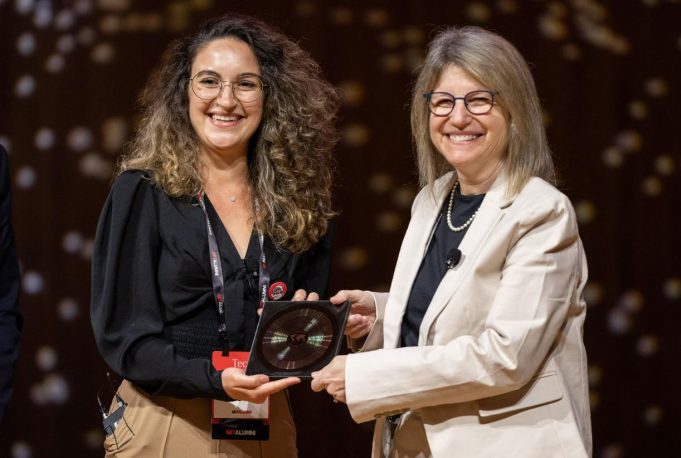
Tech Day Goes “Above and Beyond”
This article originally appeared in Slice of MIT.
MIT’s annual Technology Day symposium took alumni and guests into the far reaches of space on Saturday, June 3, as MIT faculty members shared out-of-this-world research at scales ranging from tiny nanosatellites to massive black holes.
The event—an annual highlight of MIT Tech Reunions that took place in Kresge Auditorium—also featured a fireside chat with MIT President Sally Kornbluth, the MIT Alumni Better World Service Award ceremony, and special guests from outer space!
Dubbed “Research from Above and Beyond: MIT in Space,” Tech Day drew a near-capacity crowd to Kresge, along with more than 800 alumni and friends who tuned in live from home. MIT Alumni Association (MITAA) CEO Whitney Espich introduced the program, which spotlighted cutting-edge research in five talks:
“Nanosatellites for Weather and Communications”
Kerri Cahoy, an associate professor of aeronautics and astronautics, introduced MIT’s work on CLICK, a mission to develop communications technology that will enable nanosatellites to work together. The ultimate goal, she says, is to create a “space internet.” Cahoy also shared her work on TROPICS, a mission to use nanosatellites to map hurricanes and tropical storms. “Forecasting software is only as good as the data,” she said.
“Sustainability in Space and on Earth: Research Initiatives of the Space Enabled Research Group”
Danielle Wood ’04, SM ’08, PhD ’12, an assistant professor in aeronautics and astronautics and in the Media Lab, shared her work helping African countries to develop space programs. Reducing barriers to space research will enable more countries to use satellite data for such tasks as mapping changes to the oceans and tracking deforestation, she said. Wood is director of the Space Enabled Research Group and faculty advisor to the new MIT major in African and African diaspora studies.
“Making Oxygen on Mars for Human Exploration”
Former astronaut Jeffrey Hoffman, a professor of the practice of aerospace engineering, explained the workings of MOXIE, an MIT-led project that has been successfully producing oxygen on Mars since April 2021. MOXIE works by electrochemically splitting carbon dioxide, the dominant component of Mars’ atmosphere, into oxygen ions and carbon monoxide. If MOXIE were running continuously, it could generate enough oxygen to keep a small dog alive, Hoffman said.
“Exploring Earth’s Twin”
Taylor Perron, the Cecil and Ida Green Professor of Earth, Atmospheric, and Planetary Sciences, shared his research on Titan, a moon of Saturn with remarkable similarities to Earth. Showing slides of Titan’s misty orange-hued landscapes, Perron noted that the moon has mountains and rivers like Earth’s, but the mountains are made of ice and organic compounds, and the rivers flow with liquid methane and ethane.
“Black Hole Echoes and Music of the Cosmos”
Erin Kara, the Class of 1958 Career Development Assistant Professor of Physics, shared an eerie audio clip that she called “the sound of a black hole.” Kara provided a brief introduction to the physics of black holes and explained that she created the audio clip by translating the wavelength of light readings around a black hole into musical pitches.
All the day’s talks included question-and-answer sessions moderated by Maria Zuber, the vice president for research and E. A. Griswold Professor of Geophysics. After the last of these, Zuber announced a guest appearance.
Astronauts Stephen Bowen ’93 and Warren “Woody” Hoburg ’08—both alums in reunion years—appeared by video to address the MIT crowd from aboard the International Space Station. The pair shared observations about how the human body adapts to space, gave shout-outs to fellow alums, and welcomed the new president to MIT.
Fireside Chat with President Kornbluth
Kornbluth herself then took the stage for a wide-ranging fireside chat with MITAA president Steve Baker ’84, MArch ’88. Kornbluth described MIT as a paradise for the curious, asserted that fostering belonging and freedom of expression are not mutually exclusive, and stressed the need for the Institute to continue to attract a diverse range of talent.
Kornbluth said she believes MIT is well-positioned to take a leading role in addressing climate change and the impact of artificial intelligence, and she stressed that innovators across campus need to work together to tackle societal challenges. “Historically, MIT has had a huge impact based on the work of individual brilliant scientists and engineers. Now, I think society demands more collective action,” she said.
One step on the road to collective action will be the president’s upcoming alumni listening tour. Set to kick off this fall, the tour will include visits to major cities around the world where MIT alumni and friends live and work.
As a welcoming gesture from this global alumni community, Maya Nasr ’18, PhD ’23 presented Kornbluth with a replica of the HUMANS nanowafer, a 6-inch silicon wafer that was sent to space with recordings in 64 languages by people from more than 80 countries. Nasr is the lead for the HUMANS project, which is designed as a symbolic declaration that space is for everyone.
Better World Service Award
An additional highlight of Tech Day was the presentation of the 2023 MIT Alumni Better World Service Award, which recognizes alumni who have been working “wisely, creatively, and effectively to advance the MIT ideal of the betterment of humankind.” Baker presented awards to Vanessa Feliberti Bautista ’91; Oluwasegun Ige SM ’85, PhD ’90; and Donald Rea PhD ’54.
To learn more, watch the Tech Day videos, and explore Slice coverage of MIT Reunions 2023.

